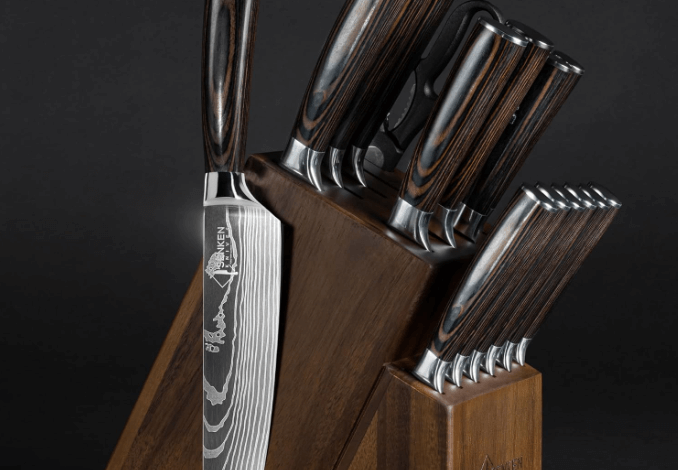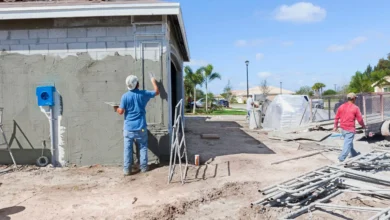Why Some Kitchen Knives Rust While Others Stay Sharp Forever

Every chef knows the heartbreak of discovering rust on their favorite kitchen knife. You’ve invested in quality blades, yet some develop unsightly orange spots while others remain pristine after years of use. The secret lies in understanding the fascinating interplay between metallurgy, craftsmanship, and proper care—knowledge that transforms how you select, use, and maintain your culinary tools.
Understanding why certain knives succumb to rust while others resist it requires delving into the science of steel composition, manufacturing techniques, and environmental factors. Whether you’re considering Japanese kitchen knives renowned for their razor-sharp edges or searching for the best UK knives for your collection, this knowledge will guide your decisions and help preserve your investment.
The truth is, rust formation isn’t random—it follows predictable patterns based on specific factors you can learn to control. By mastering these principles, you’ll not only protect your current knife set but also make informed choices when expanding your culinary arsenal.
The Science Behind Rust Formation
Rust represents a chemical reaction called oxidation, where iron atoms combine with oxygen and moisture to form iron oxide. This process requires three essential elements: iron, oxygen, and water. Kitchen environments create perfect conditions for this reaction, with constant exposure to moisture from washing, steam from cooking, and humidity from food preparation.
The oxidation process begins at the molecular level when iron atoms lose electrons to oxygen atoms in the presence of water molecules. This electron transfer creates iron oxide—the reddish-brown substance we recognize as rust. Once started, the process accelerates as rust itself becomes porous, allowing more moisture and oxygen to reach the underlying metal.
Temperature and pH levels influence rust formation speed. Acidic foods like tomatoes and citrus fruits can accelerate the process, while alkaline environments may slow it. Understanding this chemistry explains why some knives develop rust spots after cutting certain ingredients, even when cleaned immediately afterward.
Material Composition: The Foundation of Rust Resistance
Carbon Steel vs. Stainless Steel
The primary factor determining a knife’s rust susceptibility lies in its steel composition. Carbon steel, prized for its exceptional sharpness and edge retention, contains high levels of iron with minimal chromium content. This composition makes carbon steel knives incredibly sharp but vulnerable to rust formation.
Traditional Japanese knives often utilize high-carbon steel for their legendary cutting performance. These blades can achieve remarkable sharpness that surpasses many stainless steel alternatives. However, this superior performance comes with increased maintenance requirements, as carbon steel readily oxidizes when exposed to moisture.
Stainless steel knives incorporate chromium—typically 10.5% or higher—which forms an invisible protective layer called chromium oxide on the blade’s surface. This microscopic barrier prevents oxygen and moisture from reaching the underlying iron, effectively blocking rust formation. Higher chromium content provides greater rust resistance, though it may slightly reduce the blade’s ability to achieve ultra-sharp edges.
The Role of Other Alloying Elements
Modern knife manufacturers incorporate various alloying elements to enhance rust resistance while maintaining cutting performance. Molybdenum improves corrosion resistance and strengthens the steel matrix. Vanadium contributes to wear resistance and helps maintain sharp edges longer. Nickel enhances corrosion resistance and provides structural stability.
Premium knife sets often feature complex steel compositions that balance multiple properties. These advanced alloys represent centuries of metallurgical development, combining the sharpness potential of carbon steel with improved rust resistance.
Manufacturing Processes and Surface Treatments
The forging and heat treatment processes significantly impact a knife’s rust resistance. Proper tempering creates optimal grain structure while maintaining adequate chromium distribution throughout the blade. Inadequate heat treatment can create areas of varying composition, leading to differential rust susceptibility across the blade surface.
Surface finishing techniques also influence rust resistance. Mirror-polished blades present fewer microscopic irregularities where moisture can accumulate, while textured finishes may trap particles and moisture. Some manufacturers apply protective coatings or specialized treatments that enhance rust resistance without compromising cutting performance.
Japanese knife makers often employ traditional techniques that prioritize cutting performance over rust resistance. The meticulous hand-forging processes used in creating Sakuto knives and other premium Japanese blades focus on achieving optimal edge geometry and steel structure for superior cutting ability.
Different Knife Types and Rust Susceptibility
Japanese Kitchen Knives: Art Meets Function
Japanese knives represent the pinnacle of blade craftsmanship, combining centuries-old techniques with premium materials. Traditional Japanese knife sets often feature high-carbon steel that delivers unmatched sharpness but requires dedicated care to prevent rust formation.
The most coveted Japanese knives utilize specialized steels like White Steel (Shirogami) and Blue Steel (Aogami), which contain minimal chromium content. These steels can develop patina—a protective oxidation layer that actually helps prevent deeper rust formation. However, this patina development requires proper technique and timing.
Modern Japanese knife manufacturers also produce stainless steel versions that maintain traditional geometry while offering improved rust resistance. These hybrid approaches attempt to capture the best qualities of both material types.
UK-Made Knives: Tradition Meets Innovation
The best UK knives combine British manufacturing heritage with modern metallurgy. UK knife makers often emphasize durability and practicality, utilizing stainless steel compositions that provide reliable rust resistance for everyday kitchen use.
British knife manufacturers typically favor steel compositions that balance performance with low maintenance requirements. These knives may not achieve the extreme sharpness of traditional Japanese blades, but they offer consistent performance with minimal rust concerns when properly cared for.
Chef Knives and Professional Considerations
Professional chef knives must withstand constant use in demanding kitchen environments. Commercial kitchens present unique challenges with frequent washing, exposure to acidic ingredients, and limited time for detailed maintenance. Professional-grade knife sets typically prioritize rust resistance and durability over achieving maximum sharpness potential.
Many professional chefs maintain multiple knives with different characteristics—ultra-sharp Japanese knives for precision work and more rust-resistant options for general preparation tasks. This approach allows chefs to optimize performance while managing maintenance requirements.
Prevention Strategies: Protecting Your Investment
Immediate Post-Use Care
The most critical factor in preventing knife rust involves immediate care after each use. Hand washing with mild dish soap and thorough drying prevents moisture accumulation that triggers rust formation. Never leave knives soaking in water or place them in dishwashers, as prolonged moisture exposure accelerates oxidation.
Pat blades completely dry with clean towels, paying special attention to the junction between blade and handle where moisture can accumulate. For carbon steel knives, immediate drying becomes absolutely essential as these blades can develop rust spots within hours of exposure to moisture.
Proper Storage Solutions
Storage methods significantly impact rust development. Magnetic knife strips provide excellent ventilation while keeping blades easily accessible. Wooden knife blocks offer protection but require proper maintenance to prevent moisture accumulation within the slots.
Individual blade guards or sheaths protect edges while allowing air circulation. For valuable knives, consider storage solutions with desiccant packets that actively absorb ambient moisture from storage areas.
Regular Maintenance Practices
Light oiling creates a protective barrier that prevents moisture and oxygen from reaching the blade surface. Food-safe mineral oil works well for this purpose, though it requires periodic reapplication. Apply thin layers and buff excess oil to prevent rancidity.
Regular sharpening removes surface oxidation while maintaining optimal cutting performance. Professional sharpening services can address more significant rust issues while properly maintaining blade geometry.
Knife Rust Removal: Restoration Techniques
Safe DIY Methods
Minor rust spots respond well to gentle removal techniques using common household items. Baking soda mixed with water creates a mild abrasive paste that removes surface rust without damaging the blade. Apply the paste, let it sit for several minutes, then scrub gently with a soft brush or cloth.
White vinegar’s acetic acid dissolves rust effectively while being gentle enough for most blade materials. Soak affected areas for 5-10 minutes, then scrub gently and rinse thoroughly. Always dry completely after any rust removal treatment.
For stubborn rust spots, fine steel wool (0000 grade) or rust erasers provide more aggressive removal while minimizing blade damage. Work in the direction of the blade’s grain and use minimal pressure to avoid scratching the surface.
Professional Restoration Services
Valuable knives with significant rust damage benefit from professional restoration. Experienced knife services possess specialized equipment and expertise to remove rust while preserving blade geometry and finish quality. Professional restoration becomes particularly important for collectible or high-value Japanese knife sets where improper treatment could significantly reduce value.
Selecting Rust-Resistant Options
Key Features to Consider
When building a knife collection, prioritize stainless steel options with chromium content above 13% for maximum rust resistance. Look for reputable manufacturers who provide detailed steel composition information and care instructions.
Consider your cooking habits and maintenance willingness when selecting knives. Frequent home cooks who prefer low-maintenance options should focus on quality stainless steel knife sets. Culinary enthusiasts willing to invest time in proper care can explore high-carbon Japanese options for superior cutting performance.
Reading Between the Marketing Lines
Manufacturers use various terms to describe rust resistance, but understanding the underlying steel composition provides more reliable guidance. “Stain-resistant” typically indicates some rust resistance but not complete immunity. “High-carbon stainless” attempts to combine benefits of both steel types but may compromise on both fronts.
Research specific steel types and read reviews from actual users rather than relying solely on marketing claims. Experienced knife users provide valuable insights into real-world performance and maintenance requirements.
See also: Vidmate APK: The Ultimate Solution for All Your Video Downloading Needs in 2025
Preserving Your Culinary Legacy
Understanding the factors that cause knife rust empowers you to make informed decisions about selection, use, and care. Whether you choose the precision of Japanese kitchen knives or the reliability of stainless steel options, proper knowledge and maintenance techniques will preserve your investment for decades.
The relationship between knife performance and rust susceptibility represents a fundamental trade-off in metallurgy. By understanding these principles, you can select knives that match your skills, preferences, and maintenance commitment while implementing care practices that maximize their lifespan and performance.
Remember that even the finest knives require attention and care. Embrace the ritual of proper knife maintenance as part of your culinary practice—it connects you to generations of craftsmen and chefs who understood that exceptional tools deserve exceptional care.



